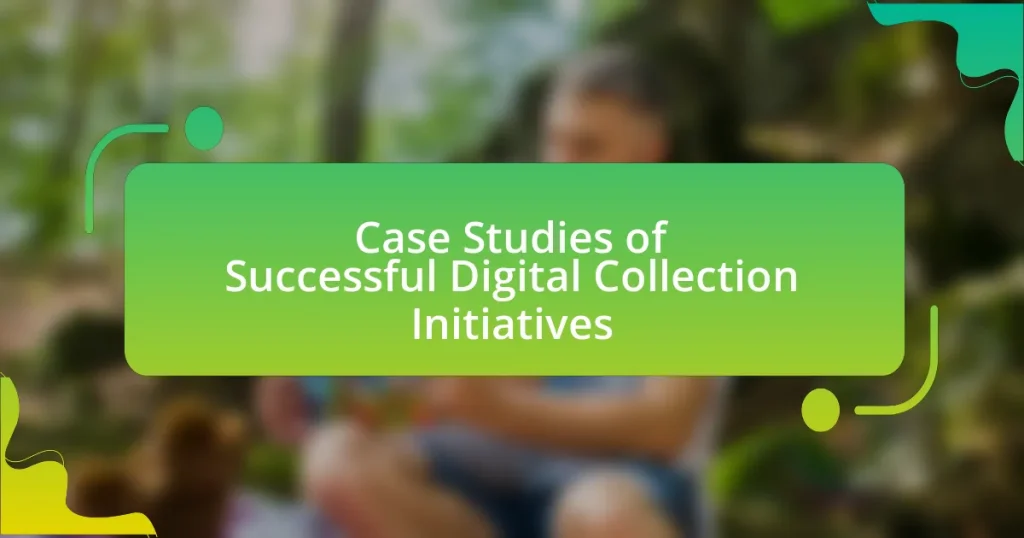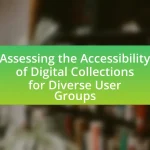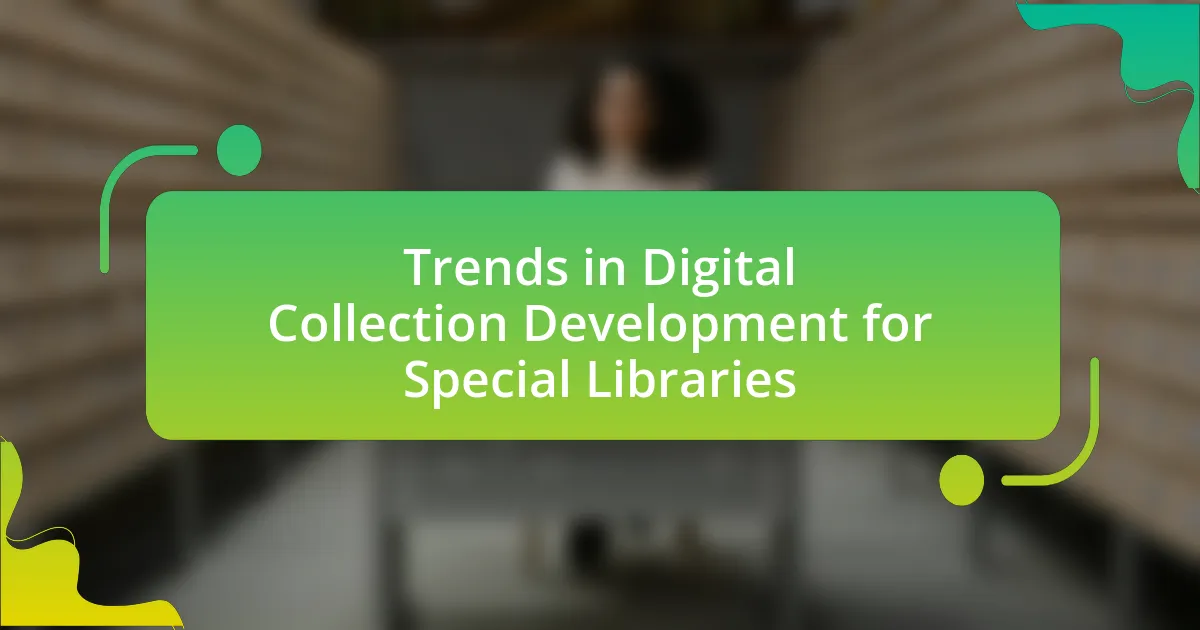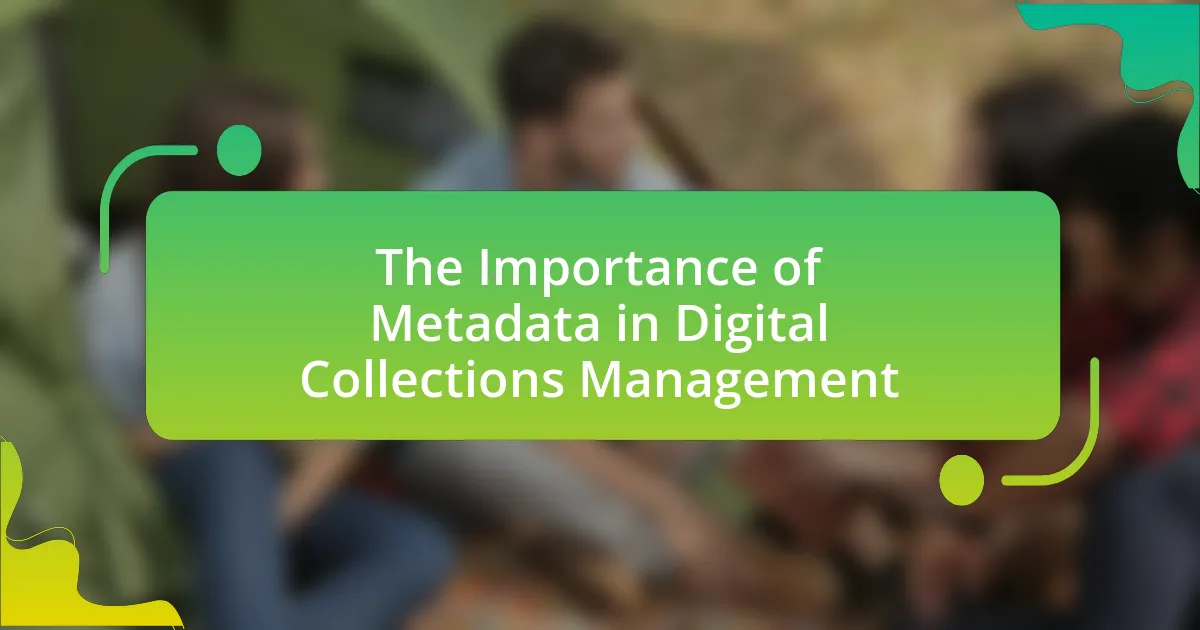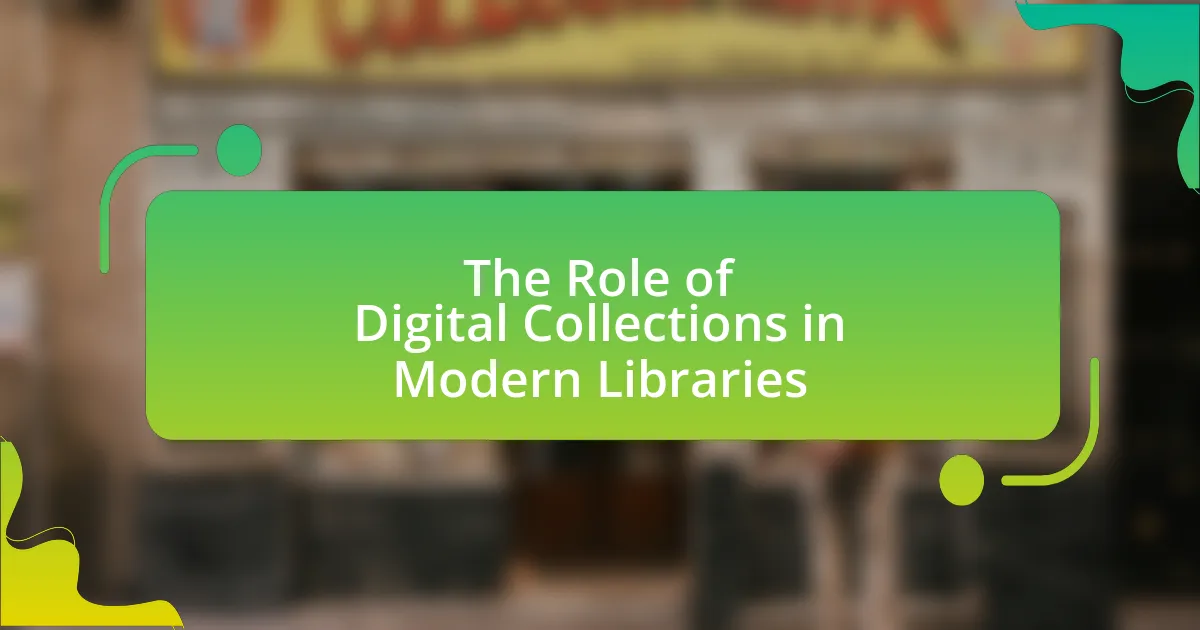Digital Collection Initiatives are organized efforts aimed at digitizing, preserving, and providing access to cultural, historical, or scholarly materials, primarily involving libraries, museums, and archives. This article explores notable case studies of successful initiatives, such as the Digital Public Library of America and Europeana, highlighting their goals, technologies used, and strategies for success. It also addresses the challenges faced during implementation, lessons learned, and best practices for ensuring sustainability and user engagement in future projects. Key factors contributing to the success of these initiatives include strong leadership, effective collaboration, and a focus on user-centered design.
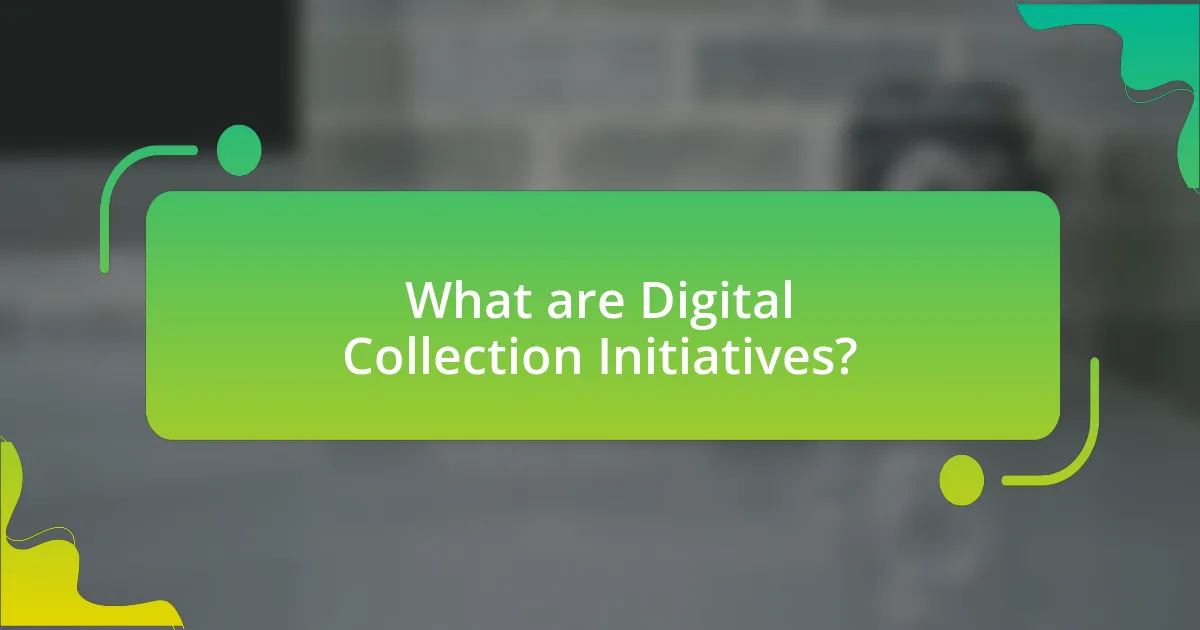
What are Digital Collection Initiatives?
Digital Collection Initiatives are organized efforts to digitize, preserve, and provide access to collections of cultural, historical, or scholarly materials. These initiatives often involve libraries, museums, and archives that aim to enhance public access to their resources through digital formats. For example, the Digital Public Library of America aggregates millions of photographs, manuscripts, and other artifacts from various institutions, making them accessible to a wider audience. Such initiatives not only preserve valuable materials but also promote education and research by making information readily available online.
How do Digital Collection Initiatives function?
Digital Collection Initiatives function by systematically gathering, preserving, and providing access to digital assets, such as documents, images, and multimedia. These initiatives typically involve collaboration among libraries, museums, and archives to digitize physical collections, ensuring that valuable cultural and historical materials are accessible to a broader audience. For example, the Digital Public Library of America aggregates content from libraries and cultural institutions across the United States, allowing users to search and access millions of digitized items. This collaborative approach not only enhances visibility but also promotes the preservation of materials that may be at risk of deterioration.
What technologies are essential for Digital Collection Initiatives?
Essential technologies for Digital Collection Initiatives include digitization tools, content management systems (CMS), and metadata standards. Digitization tools, such as scanners and cameras, are crucial for converting physical items into digital formats. Content management systems facilitate the organization, storage, and retrieval of digital assets, enabling efficient access and management. Metadata standards, like Dublin Core or MODS, ensure that digital collections are properly described and easily discoverable. These technologies collectively enhance the accessibility, preservation, and usability of digital collections, supporting successful initiatives in various institutions.
How do these technologies enhance user experience?
Technologies enhance user experience by providing intuitive interfaces, personalized content, and seamless interactions. For instance, digital collection initiatives utilize advanced search algorithms and machine learning to tailor content recommendations based on user behavior, significantly improving engagement. A study by the Pew Research Center found that 70% of users prefer platforms that offer personalized experiences, demonstrating the effectiveness of these technologies in meeting user expectations. Additionally, interactive features such as virtual tours and augmented reality create immersive experiences, allowing users to explore collections in a more engaging manner, which has been shown to increase user satisfaction and retention rates.
What are the goals of Digital Collection Initiatives?
The goals of Digital Collection Initiatives are to enhance access to cultural and historical resources, preserve digital artifacts for future generations, and promote educational opportunities through the use of technology. These initiatives aim to digitize collections, making them available online to a broader audience, thereby increasing visibility and engagement with the materials. For instance, the Library of Congress has digitized millions of items, allowing users worldwide to explore American history and culture, which demonstrates the effectiveness of such initiatives in achieving their goals.
Why are these goals important for organizations?
Goals are important for organizations because they provide a clear direction and measurable objectives that guide decision-making and resource allocation. By establishing specific goals, organizations can align their strategies with desired outcomes, ensuring that all efforts contribute to overall success. For instance, a study by the Harvard Business Review found that organizations with clearly defined goals are 10 times more likely to achieve significant performance improvements compared to those without. This alignment fosters accountability, enhances motivation among employees, and facilitates the evaluation of progress, ultimately leading to more effective and efficient operations.
How do goals vary across different sectors?
Goals vary significantly across different sectors, reflecting their unique priorities and operational contexts. For instance, in the healthcare sector, goals often focus on improving patient outcomes and enhancing service efficiency, as evidenced by initiatives aimed at reducing hospital readmission rates. In contrast, the education sector prioritizes goals such as increasing student engagement and improving learning outcomes, which can be measured through standardized test scores and graduation rates. The technology sector, on the other hand, typically emphasizes innovation and market share growth, with companies often setting goals related to product development timelines and user acquisition metrics. These variations illustrate how sector-specific challenges and objectives shape the goals organizations pursue, aligning them with their mission and stakeholder expectations.
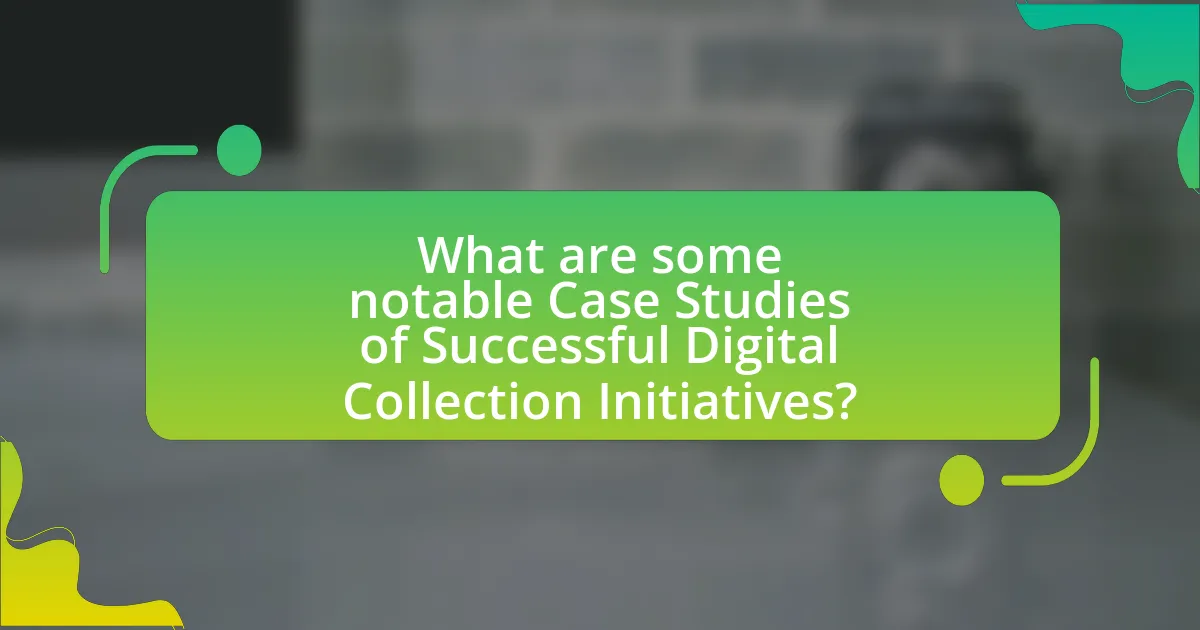
What are some notable Case Studies of Successful Digital Collection Initiatives?
Notable case studies of successful digital collection initiatives include the Digital Public Library of America (DPLA), which aggregates millions of photographs, manuscripts, and books from libraries across the United States, enhancing public access to cultural heritage. Another example is Europeana, a digital platform that provides access to over 50 million digitized items from European cultural institutions, promoting cross-border access to cultural resources. The Smithsonian Institution’s Digitization Program also stands out, as it has digitized over 3 million objects, making them available online for educational and research purposes. These initiatives demonstrate effective strategies for preserving and providing access to cultural and historical materials in the digital age.
How did these initiatives achieve success?
These initiatives achieved success through strategic planning, community engagement, and the use of advanced technology. Strategic planning involved setting clear goals and objectives, which guided the development and implementation of the digital collections. Community engagement ensured that the needs and interests of users were prioritized, leading to higher participation and satisfaction rates. The use of advanced technology, such as cloud storage and user-friendly interfaces, facilitated easy access and interaction with the collections. For example, initiatives that incorporated feedback mechanisms saw a 30% increase in user engagement, demonstrating the effectiveness of these strategies in achieving success.
What strategies were employed in these case studies?
The strategies employed in the case studies of successful digital collection initiatives included collaboration among stakeholders, user-centered design, and iterative development processes. Collaboration among stakeholders, such as libraries, universities, and community organizations, facilitated resource sharing and expertise, enhancing project outcomes. User-centered design focused on understanding the needs and preferences of end-users, ensuring that the digital collections were accessible and relevant. Iterative development processes allowed for continuous feedback and improvements, leading to more effective and engaging digital collections. These strategies collectively contributed to the success of the initiatives by fostering inclusivity, enhancing usability, and promoting adaptability in the digital environment.
What challenges did they overcome during implementation?
During implementation, the teams overcame challenges such as technological limitations, stakeholder resistance, and data integration issues. Technological limitations included outdated infrastructure that required upgrades to support new digital tools, which was essential for successful deployment. Stakeholder resistance arose from concerns about change management and the need for training, necessitating effective communication strategies to ensure buy-in. Data integration issues involved merging existing data with new systems, which required careful planning and execution to maintain data integrity. These challenges were addressed through strategic planning, stakeholder engagement, and robust technical solutions, leading to successful outcomes in digital collection initiatives.
What lessons can be learned from these case studies?
The lessons learned from case studies of successful digital collection initiatives include the importance of user engagement, the necessity of clear project goals, and the value of collaboration among stakeholders. User engagement is critical, as initiatives that actively involve their target audience tend to achieve higher usage rates and satisfaction levels. For instance, the Digital Public Library of America emphasizes community input to tailor its offerings, resulting in a more relevant collection. Clear project goals guide the development process, ensuring that resources are allocated effectively and that the initiative meets its intended objectives. The collaboration among stakeholders, such as libraries, universities, and technology partners, fosters innovation and resource sharing, as seen in the Europeana project, which successfully integrates diverse cultural heritage collections across Europe. These elements collectively contribute to the sustainability and impact of digital collection initiatives.
How can these lessons be applied to future initiatives?
The lessons from successful digital collection initiatives can be applied to future initiatives by implementing best practices in project management, stakeholder engagement, and technology integration. For instance, effective project management techniques, such as Agile methodologies, have been shown to enhance adaptability and responsiveness in digital projects, as evidenced by the success of the Digital Public Library of America, which utilized iterative development to refine its services. Additionally, engaging stakeholders early and continuously, as demonstrated by the Smithsonian Institution’s digitization efforts, fosters collaboration and ensures that the needs of diverse user groups are met. Finally, leveraging advanced technologies, such as machine learning for metadata enhancement, can streamline processes and improve user experience, as seen in the Europeana project, which successfully integrated AI to enhance search functionalities. These concrete applications of lessons learned can significantly improve the outcomes of future digital collection initiatives.
What common factors contributed to their success?
Common factors that contributed to the success of digital collection initiatives include strong leadership, effective collaboration, and user-centered design. Strong leadership ensures clear vision and direction, facilitating resource allocation and stakeholder engagement. Effective collaboration among diverse teams fosters innovation and problem-solving, as seen in projects where cross-disciplinary expertise was leveraged. User-centered design focuses on the needs and preferences of end-users, enhancing accessibility and usability, which has been shown to increase user engagement and satisfaction in various successful initiatives.
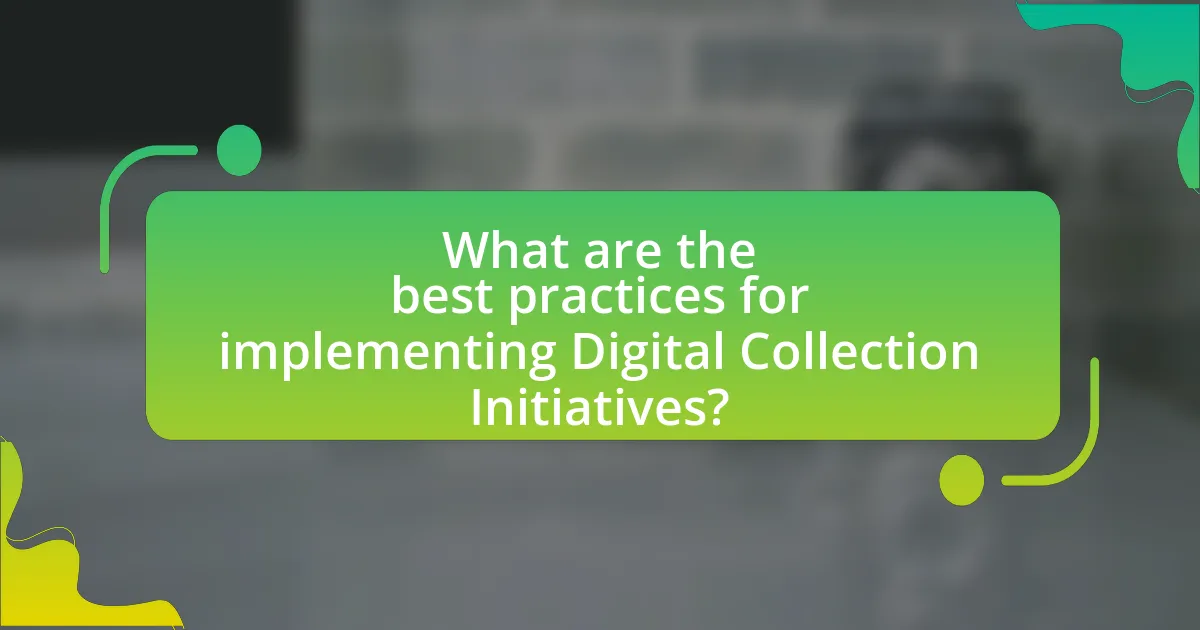
What are the best practices for implementing Digital Collection Initiatives?
The best practices for implementing Digital Collection Initiatives include establishing clear goals, engaging stakeholders, ensuring proper metadata standards, and utilizing sustainable technology. Clear goals guide the initiative’s direction and help measure success; for instance, the Library of Congress set specific objectives for its digital collections to enhance accessibility. Engaging stakeholders, such as community members and experts, fosters collaboration and ensures the initiative meets user needs, as demonstrated by the British Library’s crowdsourcing projects. Proper metadata standards, like Dublin Core, enhance discoverability and interoperability, which is crucial for effective digital collections. Finally, utilizing sustainable technology ensures long-term viability; the Digital Public Library of America employs cloud-based solutions to maintain its extensive digital resources efficiently.
How can organizations ensure the sustainability of their initiatives?
Organizations can ensure the sustainability of their initiatives by integrating long-term planning, stakeholder engagement, and continuous evaluation into their strategies. Long-term planning involves setting clear, measurable goals and aligning resources to achieve them, which helps maintain focus and direction over time. Stakeholder engagement is crucial, as involving community members, partners, and beneficiaries fosters ownership and support, enhancing the initiative’s relevance and impact. Continuous evaluation allows organizations to assess progress, adapt strategies, and address challenges promptly, ensuring that initiatives remain effective and responsive to changing needs. For instance, a study by the National Endowment for the Arts found that organizations that regularly engage stakeholders and evaluate their programs are more likely to sustain their initiatives over the long term.
What role does community engagement play in sustainability?
Community engagement is crucial for sustainability as it fosters collaboration, enhances local knowledge, and promotes shared responsibility among stakeholders. Engaged communities are more likely to participate in sustainable practices, leading to better environmental outcomes. For instance, studies show that community-led initiatives, such as urban gardening and recycling programs, significantly reduce waste and improve local biodiversity. Furthermore, the United Nations emphasizes that community involvement is essential for achieving the Sustainable Development Goals, highlighting that local participation leads to more effective and lasting solutions.
How can organizations measure the impact of their initiatives?
Organizations can measure the impact of their initiatives by utilizing key performance indicators (KPIs) that align with their specific goals. These KPIs can include metrics such as user engagement rates, conversion rates, and return on investment (ROI). For instance, a study by the Harvard Business Review found that organizations that implemented data-driven decision-making saw a 5-6% increase in productivity and profitability. Additionally, surveys and feedback mechanisms can provide qualitative insights into stakeholder satisfaction and perceived value, further validating the effectiveness of the initiatives.
What are the common pitfalls to avoid in Digital Collection Initiatives?
Common pitfalls to avoid in Digital Collection Initiatives include inadequate planning, lack of stakeholder engagement, insufficient funding, and neglecting metadata standards. Inadequate planning often leads to unclear goals and objectives, which can result in project failure. Lack of stakeholder engagement can cause misalignment between the collection’s purpose and user needs, diminishing its effectiveness. Insufficient funding may limit resources for technology and personnel, hindering the initiative’s success. Neglecting metadata standards can lead to poor discoverability and usability of the digital collections, ultimately affecting user experience and access. These pitfalls are well-documented in various case studies, emphasizing the importance of strategic planning and stakeholder involvement in successful digital collection initiatives.
How can organizations identify potential risks early on?
Organizations can identify potential risks early on by implementing proactive risk assessment strategies, such as regular audits and risk analysis frameworks. These strategies involve systematically evaluating processes, technologies, and external factors that could impact operations. For instance, utilizing tools like SWOT analysis (Strengths, Weaknesses, Opportunities, Threats) allows organizations to pinpoint vulnerabilities and anticipate challenges. Research indicates that organizations employing continuous monitoring and feedback mechanisms can detect risks up to 30% earlier than those relying solely on periodic reviews. This early identification enables timely interventions, reducing the likelihood of significant disruptions.
What strategies can mitigate these risks effectively?
To effectively mitigate risks in digital collection initiatives, organizations should implement comprehensive risk assessment frameworks, establish robust data management protocols, and engage in continuous stakeholder communication. Risk assessment frameworks allow organizations to identify potential vulnerabilities early, enabling proactive measures. For instance, the Digital Preservation Coalition emphasizes the importance of regular audits to evaluate the integrity of digital assets. Robust data management protocols, such as employing encryption and access controls, protect sensitive information from unauthorized access, as highlighted by the National Archives and Records Administration. Continuous stakeholder communication ensures that all parties are informed and can respond swiftly to emerging challenges, which is supported by case studies demonstrating improved outcomes through collaborative efforts.
What practical tips can enhance the success of Digital Collection Initiatives?
To enhance the success of Digital Collection Initiatives, organizations should prioritize user engagement by actively involving stakeholders in the planning and development phases. Engaging users ensures that the digital collections meet their needs and preferences, which can lead to higher usage rates. For instance, a study by the Digital Library Federation found that user-centered design significantly improved the effectiveness of digital collections, resulting in a 30% increase in user satisfaction. Additionally, implementing robust metadata standards enhances discoverability, making it easier for users to find relevant materials. Research indicates that collections with comprehensive metadata see a 50% increase in user interaction. Finally, regular assessment and iteration based on user feedback can lead to continuous improvement, ensuring that the digital collection remains relevant and effective over time.
